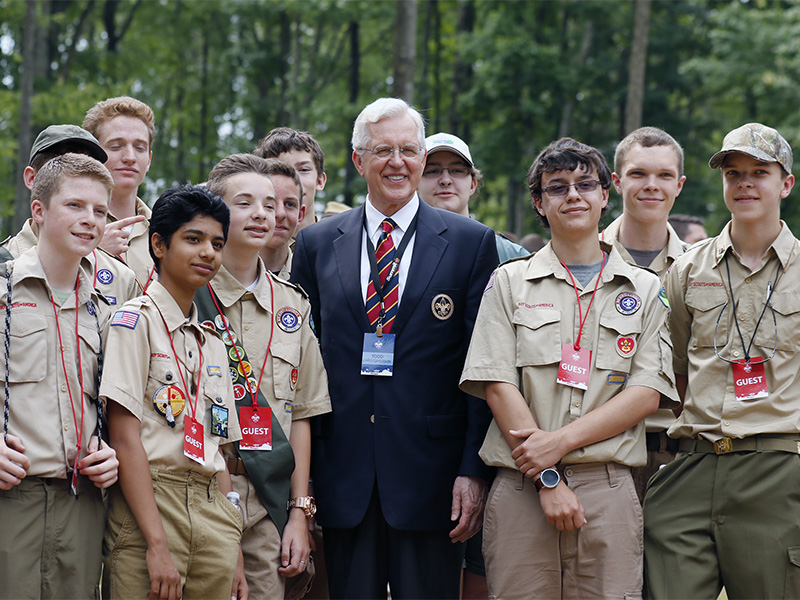(RNS) This week, the Mormon church announced it will be scaling back its long-standing relationship with the Boy Scouts of America. The partnership will continue as before for boys ages 8 to 13, but will no longer include the Varsity and Venturing programs for boys ages 14 to 18.
And it’s possible this change is only the beginning. The Deseret News reports:
The church will continue to sponsor Cub Scouts for boys 8 to 10 and Boy Scout programs for those 11 through 13 in those two countries, but statements released by the church about the announcement signaled that it may drop those programs in the future, too.
As the Deseret News put it, “the overhaul is stunning, because Scouting has been an indelible, seemingly inseparable, part of the LDS Church’s Young Men program for 104 years.”
(To me it’s also stunning for the simple reason that Thomas S. Monson is still alive. Monson, the president of the Church of Jesus Christ of Latter-day Saints, has long been an enormous supporter of the Scouting program.)
So what does this mean for the LDS church? What advantages might there be?
And why is this happening now?
To many people, the answer about the timing is that the BSA’s policies about welcoming gay and transgender members have become a source of deep tension.
The press release says this was not a factor, however, and that the BSA “has always allowed the Church to operate its programs in ways that are consistent with our standards and beliefs.”
I would hypothesize the impetus behind this is larger and more far-reaching than conflicts over LGBT issues.
As I noted in an earlier column, the church has recently indicated its rising concern with youth leaving. In the overall picture of modern LDS history, the announcement about the church’s evolving relationship with the Scouting program may have more to do with its internal concerns about retention than with any issues it has with the BSA.
I recently read an outstanding article by BYU historian Rebecca de Schweinitz called “Holding on to the ‘Chosen Generation’: The Mormon Battle for Youth in the 1960s and Early 1970s,” which traces what happened 50 years ago, the last time the LDS church found itself with a widespread youth retention problem.
In American culture, most religious groups were struggling with a generation gap in a period of massive youth protest and social instability. Other religions’ solution was to de-emphasize doctrine and move toward “youth programs centered on entertainment, self-fulfillment, and collaboration with external entities on social justice issues.”
The LDS church responded to the same problem quite differently. It doubled down and created demanding internal church programs that focused on keeping youth in the fold:
- Between 1965 and 1971, the number of students enrolled in LDS seminary (a morning program for Mormon high school students), increased by about 40 percent and the number of Institute programs (religious education for young adults ages 18-30) actually doubled.
- In 1965, the church created a curriculum for Family Home Evening (a weekly time of religious instruction and prayer), and in 1970, it set aside Monday “as a church-wide family night.”
- In 1969, it pioneered the Bishop’s Youth Council in local wards, giving youth more direct involvement in leadership.
- From 1965 to the end of the decade, the church started almost 300 LDS Student Association groups on college campuses.
- In 1971, it created a Big Brother/Big Sister-like program through the M-Men and Gleaners organizations. This channeled an idealistic generation into service projects designed by the church.
- Also, that year, it debuted the “New Era” magazine for youth, replacing the old-school “Improvement Era” with a periodical that felt more culturally relevant and modern.
All in all, de Schweinitz says, the LDS church “channeled youth efforts internally, that is, into strengthening the LDS community as an institution and as the chief source of young people’s identity.”
I think we’re there again: The church is navigating a period of growing disaffection among youth and young adults. And if retrenchment into a deep well of intra-LDS organizations and programs worked the last time, then by golly, in the eyes of the church, it’s worth attempting again.
I believe the church when it says the new BSA split was not primarily caused by concern about LGBT issues. I believe it because of statements like these in its press release about changes to the youth program:
“The activities referenced on lds.org/youth/activities and ymactivities.lds.org have been in place since 2013 as a resource for youth and their leaders around the world. When followed, these activities can provide better opportunities for spiritual, physical, emotional and intellectual growth.”
In this vein, we can see the changes to the youth program as a sign that Mormon leaders are gamely trying to address a bigger issue: how to create and maintain youth programs that do a better job of keeping LDS young people tied to the church. The 2012 lowering of the missionary age is relevant here, and the 2015 deepening of the college-age Institute system to encourage retention and graduation, and last year’s changes to the high school seminary curriculum.
This is more than just the occasional tinkering that’s needed to keep any program running smoothly. This is a crusade for Mormon youth.
So I would expect more changes to be coming down the pike. That includes the hinted-at changes to the budget for the Young Women organization. Whether programmatic and institutional solutions are the best way to speak to a generation that has been suspicious of institutions is a question worth asking … but such an effort certainly worked half a century ago. Perhaps it will help now.
(Jana Riess is a senior columnist for RNS where she writes the “Funkling Sainthood” column)






